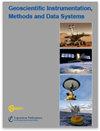Design and operation of a long-term monitoring system for spectral electrical impedance tomography (sEIT)
IF 2.3
4区 地球科学
Q3 GEOSCIENCES, MULTIDISCIPLINARY
引用次数: 2
Abstract
Abstract. Spectral electrical impedance tomography (sEIT) is increasingly used to characterize the structure of subsurface systems. Additionally, petrophysical and biogeophysical processes are characterized and monitored using sEIT. The method combines multiple, spatially distributed, spectroscopic measurements with tomographic inversion algorithms to obtain images of the complex electrical resistivity distribution in the subsurface at various frequencies. Spectral data, as well as polarization measurements provide additional information about the systems under investigation, and can be used to reduce ambiguities that occur if only the in-phase resistivity values are analysed. However, spectral impedance measurements are very sensitive to details of the measurement setup, as well as external noise and error components. Despite promising technical progress in improving measurement quality, as well as progress in the static characterisation and understanding of electrical polarisation signatures of the subsurface, long-term monitoring attempts are still rare. Yet, measurement targets often show inherent non-stationarity that would require such approaches for a proper system characterisation. With the aim of improving operating foundations for similar endeavours, we here report on the design and field deployment of a permanently installed monitoring system for sEIT data. The specific aim of this monitoring installation is the characterisation of crop root evolution over a full growing season, requiring multiple measurements per day over multiple months to capture relevant system dynamics. In this contribution, we discuss the general layout and design of the monitoring system, including the core measurement system, additional on-site equipment, required corrections to improve data quality for high frequencies, data management, and remote processing facilities used to analyse the generated data. The choice and installation of electrodes, cables, and measurement configurations are discussed, as well as quality parameters used for the continuous assessment of system functioning and data quality. Exemplary analysis results of the first season of operation highlight the importance of continuous quality control. It is also found that proper cable elevation decreased capacitive leakage currents and in combination with the correction of inductive effects lead to consistent tomographic results up to 1 kHz measurement frequency. Overall, the successful operation of an sEIT monitoring system over multiple months with multiple daily tomographic measurements was achieved.频谱电阻抗断层扫描(sEIT)长期监测系统的设计与运行
摘要谱电阻抗断层成像(sEIT)越来越多地用于表征地下系统的结构。此外,还利用sEIT对岩石物理和生物地球物理过程进行了表征和监测。该方法将多个空间分布的光谱测量与断层反演算法相结合,以获得不同频率下地下复杂电阻率分布的图像。光谱数据以及极化测量提供了关于所研究系统的额外信息,并且可以用于减少如果仅分析同相电阻率值时出现的模糊性。然而,频谱阻抗测量对测量设置的细节以及外部噪声和误差分量非常敏感。尽管在提高测量质量方面取得了可喜的技术进展,在静态表征和理解地下电极化特征方面也取得了进展,但长期监测的尝试仍然很少。然而,测量目标往往表现出固有的非平稳性,这需要这种方法来进行适当的系统表征。为了改善类似工作的操作基础,我们在此报告永久安装的sEIT数据监测系统的设计和现场部署情况。该监测装置的具体目的是描述整个生长季节的作物根系进化,需要在几个月内每天进行多次测量,以捕捉相关的系统动态。在这篇文章中,我们讨论了监测系统的总体布局和设计,包括核心测量系统、额外的现场设备、提高高频数据质量所需的校正、数据管理以及用于分析生成数据的远程处理设施。讨论了电极、电缆和测量配置的选择和安装,以及用于持续评估系统功能和数据质量的质量参数。运营第一季的示例性分析结果突出了持续质量控制的重要性。还发现,适当的电缆高度降低了电容性泄漏电流,并与电感效应的校正相结合,导致高达1kHz测量频率的一致断层摄影结果。总的来说,sEIT监测系统在多个月内成功运行,每天进行多次断层摄影测量。
本文章由计算机程序翻译,如有差异,请以英文原文为准。
求助全文
约1分钟内获得全文
求助全文
来源期刊

Geoscientific Instrumentation Methods and Data Systems
GEOSCIENCES, MULTIDISCIPLINARYMETEOROLOGY-METEOROLOGY & ATMOSPHERIC SCIENCES
CiteScore
3.70
自引率
0.00%
发文量
23
审稿时长
37 weeks
期刊介绍:
Geoscientific Instrumentation, Methods and Data Systems (GI) is an open-access interdisciplinary electronic journal for swift publication of original articles and short communications in the area of geoscientific instruments. It covers three main areas: (i) atmospheric and geospace sciences, (ii) earth science, and (iii) ocean science. A unique feature of the journal is the emphasis on synergy between science and technology that facilitates advances in GI. These advances include but are not limited to the following:
concepts, design, and description of instrumentation and data systems;
retrieval techniques of scientific products from measurements;
calibration and data quality assessment;
uncertainty in measurements;
newly developed and planned research platforms and community instrumentation capabilities;
major national and international field campaigns and observational research programs;
new observational strategies to address societal needs in areas such as monitoring climate change and preventing natural disasters;
networking of instruments for enhancing high temporal and spatial resolution of observations.
GI has an innovative two-stage publication process involving the scientific discussion forum Geoscientific Instrumentation, Methods and Data Systems Discussions (GID), which has been designed to do the following:
foster scientific discussion;
maximize the effectiveness and transparency of scientific quality assurance;
enable rapid publication;
make scientific publications freely accessible.
 求助内容:
求助内容: 应助结果提醒方式:
应助结果提醒方式:


